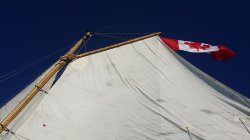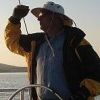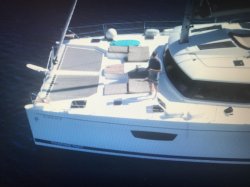
Student
Wilfred Darr
Calgary, Canada
More User info
Skipper Level II
Status: Big Time Sailor
Qualified days: 28
Posted 2018, Feb 06 13:44
...Tide tables should be checked when entering shallower waters
False...why is this the case?

Student
Rudy York
Rockwall, TX, USA
More User info
Skipper Level IV
Status: Big Time Sailor
Qualified days: 107
Posted 2019, Feb 14 15:12
The web page www.cigua.com no longer works. Wikipedia might be a better resource.

Student
Rudy York
Rockwall, TX, USA
More User info
Skipper Level IV
Status: Big Time Sailor
Qualified days: 107
Posted 2019, Feb 27 21:43
"When sailing closed hauled on a catamaran in heavier air, move the traveler up wind (on the opposite side of the sail) and let off on the main sheet. This will allow the boom to rise a little and "twist out" the top of the sail. Twisting the sail allows you to let some of the top part of the sail "deflate" in case of slightly stronger winds. In light air, make sure that the top of the mainsail is not "loosing air" meaning, keep the traveler close to the center and tighten the mainsheet pretty good to make sure the main cannot open up at the top.
As soon as the breeze kicks up, bring your traveler up a bit more and ease the mainsheet so that the boom does not come past center point."
This seems backwards to my logic. I have used the traveler to compensate for the vertical gradient of true wind, i.e. the wind speed at the top of the mast would be higher than lower due to friction of the water surface. By moving the traveler to windward and easing the sheet adds twist to the sail, changing the angle of attack at the top of the sail. In higher winds, moving the traveler to leeward would allow the sail to bleed off the pressure and in the case of a monohull, reduce the heeling.

Student
Rudy York
Rockwall, TX, USA
More User info
Skipper Level IV
Status: Big Time Sailor
Qualified days: 107
Posted 2019, Feb 27 22:26
It seems that back winding the jib while tacking a monohull would be a good idea also, especially in light winds where there may be less momentum going into the tack.

Student
Rudy York
Rockwall, TX, USA
More User info
Skipper Level IV
Status: Big Time Sailor
Qualified days: 107
Posted 2019, Feb 27 22:38
The traveler moved to leeward when sailing downwind, especially on a run, can act as a preventer on an accidental gybe, limiting the boom swing and preventing the boom from crashing into the shroud. Generally, I would suggest setting the mainsail angle to wind from haul to run by the traveler and use the mainsheet to shape or add twist to the sail.

Student
Wilfred Darr
Calgary, Canada
More User info
Skipper Level II
Status: Big Time Sailor
Qualified days: 28
Posted 2019, Aug 12 12:43
Note there is a mistake in the Heat Exchanger Diagram: it should be hot to hot, cold to cold: the flows should be in opposite directions so that there is maximum temperature differential between the fluids throughout the exchange.

Student
Charles Berry
San Diego, CA, USA
More User info
Captain Level V
Status: Really Big Time Sailor
Qualified days: 486
Posted 2019, Dec 20 07:29
Where does the 20 hours come from on the 150 amp hr battery in the example.

Student
Michel Rochon
Blainville, QC, Canada
More User info
Captain Level IV
Status: Really Big Time Sailor
Qualified days: 120
Posted 2020, May 01 13:57
what about Ciguatera, this parasite found in many caribeann fishes. Is there a way to know beforehand?
![avatar]()
Student
Ken Albright
Coupeville, WA, USA
More User info
Skipper Level II
Status: Big Time Sailor
Qualified days: 39
Posted 2021, Dec 24 22:37
Throughout the training I keep reading about chopping the painter or wrapping a line around the prop. The folks at San Juan Sailing teach keeping the dinghy close at all times. Problem eliminated. Even while maneuvering in the marina. What is the downside to this approach and why doesn’t everyone do it?

Student
Jeffrey Milum
Mill Valley, CA, USA
More User info
Bareboat Charter Master Level IV
Status: Big Time Sailor
Qualified days: 127
Posted 2022, Mar 27 06:44
On the instructions for the impeller change it says: Leave engine cowling open and do not start for 1 hour as cold water instantly against a hot engine can cause the engine head to crack.
I don't understand why the raw sea water is not "cold." What has changed from when the engine was running before, the impeller is still drawing up the same water, and it is going into the heat exchangert, which is designed for cold water when the engine is running, isn't it?